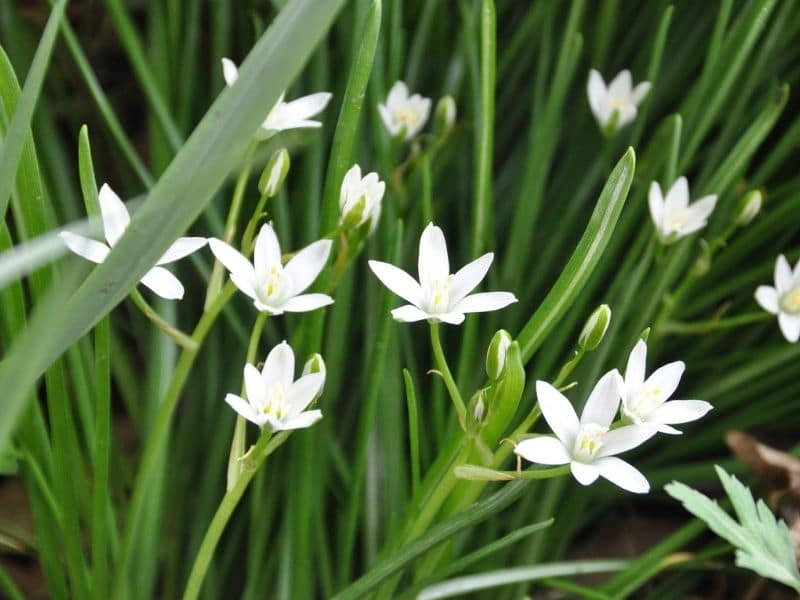In many places, Star of Bethlehem or snake flower (scientifically known as Ornithogalum) is considered invasive, as it rapidly overtakes flower beds. However, as long as you keep it properly contained, there are plenty of reasons to cultivate it in your garden.
In fact, it can be almost impossible to get rid of the Star of Bethlehem once it’s set roots, since it will rapidly overtake other plants in flower beds. That’s really too bad, since this plant is one that is truly remarkable to behold. It produces numerous star-shaped flowers on tall stems above draping foliage.
Because of its invasive nature, many gardeners choose to plant it in containers. You can also grow this plant near early-blooming flowers like dianthus and hellebores. In some places, it’s advised that you don’t plant Star of Bethlehem at all, since it’s considered noxious or even invasive (Alabama is one such example).

Varieties of Ornithogalum Plant You Can Grow
Star of Bethlehem is technically an entire genus of plants, a genus that is named as such for its star-shaped flowers that look like the Star of Bethlehem that appeared in the biblical account of Jesus’ birth.
There are many kinds of species within this genus, up to 300, in fact! However, many botanists only recognize about 150 related species of this flower.
Because it is such a large genus, it has been divided into multiple subgenera – 15 total. The best-known species are as follows.
Ornithogalum umbellatum
Perhaps the most common species of Star of Bethlehem, this bulbous perennial has pretty white flowers with green borders that bloom in the late spring or late summer.
Interestingly, this plant will produce blooming flowers only when the weather is warm enough and there is plenty of sunlight. If the weather is dull and dreary, the flower will remain closed, only showing off their green exteriors.
These are the most invasive kinds of flowers and should only be planted where they will not crowd out other plants.
Ornithogalum magnum
Ornithogalum magnum, sometimes known as the Arabian Star Flower, is native to the Mediterranean and is very similar in appearance to Ornithogalum umbellatum.
This kind of flower produces up to 15 sweet-scented star-shaped flowers. These tend to be white and are about two inches across, blooming in the late spring or early summer months. They grow best when summers remain warm and dry.
Ornithogalum dubium
This is a less-known type. Also a bulbous perennial, it produces a large cluster of up to 25 yellow or bright orange flowers apiece. Ornithogalum dubium is commonly known as the “Sun Star” or “Orange Star” due to its vibrant orange flowers that resemble miniature stars.
This orange star plant grows well in cut flower gardens as well as in rock gardens. The orange star plants naturalize easily but don’t usually take over the entire space.
Ornithogalum thyrsoides
This kind is native to South Africa. It also produces white flowers but these tend to be tinged with green in the center. They bloom in late spring or early summer and are best for using cut flowers as well as in containers or borders.
Ornithogalum nutans
Sometimes referred to as the Dropping Star of Bethlehem, this plant is found in Turkey and Bulgaria. It produces white flowers that are shaped much like bells. These bloom a bit earlier, generally in the mid to late spring.
How to Care for Star of Bethlehem Flower

Planting
If you do decide to plant Star of Bethlehem, the best time to do so is in the fall. Plant your flower bulbs about two inches apart at a depth of five inches to the bulb’s base.
Unless you are planting in a container, a good way to address this plant’s semi-invasive nature is to plant the bulbs in an area that is lined and edged so the bulbs can’t spread outside of the beds. You should also deadhead the flowers before seeds develop so that the plant does not waste energy on seed development versus flower development.
Otherwise, growing Star of Bethlehem is relatively easy. It just needs fertile soil! You can divide bulbs to propagate it easily once you’re’ ready to do so.
Watering
The Star of Bethlehem plant requires moderate watering to thrive. Water the plant when the top inch of soil feels dry to the touch, typically every 7-10 days during the growing season.
Provide enough water to keep the soil moist, allowing excess water to drain away freely from the pot’s drainage holes. During the plant’s dormant period, reduce watering frequency to once every 2-3 weeks to prevent waterlogging and rot.
Avoid overwatering, as soggy soil can lead to root rot and other moisture-related issues. Maintaining consistent moisture levels promotes healthy growth and flowering in the Star of Bethlehem plant
Soil Type
These bethlehem flowers thrive in well-draining, sandy soil with a slightly acidic to neutral pH. A soil mixture composed of equal parts potting soil, perlite, and coarse sand provides excellent drainage while allowing air circulation around the roots.
Also, adding organic matter like peat moss or compost can improve the structure and richness of the soil, which helps plants grow strong roots and leaves. It is important to maintain adequate soil moisture for Ornithogalum plants to grow optimally.
Avoid compacted or waterlogged soil, as they can lead to bulb rot and other moisture-related issues. Providing well drained soil ensures optimal growing conditions for Ornithogalum plants, encouraging robust growth and prolific flowering.
Light
Ornithogalum plants prefer bright, indirect light or partial shade for optimal growth and flowering. Place them in a bright location where they receive at least six hours of sunlight per day, such as a south or west-facing window.
While they can tolerate some direct sunlight, avoid exposure to intense midday full sun, which can scorch their foliage. Place them in a sunny location near windows with sheer curtains or blinds to filter the sunlight and prevent leaf burn.
Outdoors, provide dappled shade or shelter them from harsh afternoon sunlight.
Temperature
Star of Betheleme is winter hardy to the United States Department of Agriculture Zone 3 as long as you mulch carefully to keep the bulbs warm during the winter months. In zones 4 to 8, it can be grown without mulch, although mulching does not hurt.
Fertilizing and Pruning
Besides watering every now and then, there is very little you need to do to care for your Star of Bethlehem plant. In fact, fertilizing is not recommended, as it can cause the new growth to spread too far. You also do not need to prune the plant, although you can remove the entire bug if it spreads too much and you find that you need to control its spread any further.
Some people believe that cutting back the plant will stop it from overtaking the rest of the garden, but this is not the case. To get rid of it, you will need to remove the entire flower bulb. Even herbicides won’t do the trick – you’ll have to fully remove hp lant.
Other Concerns for Star of Bethlehem
There are very few pests and diseases that are known to afflict Star of Bethlehem, which is one of the reasons why this plant can so easily become invasive.
However, it is important to note that this plant contains dangerous alkaloids that can be poisonous to animals and livestock, including cats and dogs. Be mindful of this and don’t plant the flower if you have pets that like to nibble!
That said, when used correctly, there are some people who are able to use this flower for medicinal purposes. Historically, Star of Bethlehem was used to treat coughs, strengthen cardiovascular functioning, and prevent infection. Other cultures have used the flower when boiled and eaten like potatoes.
Both the leaves and bulb can be harvested, but be cautious about using them before consulting with your doctor.
FAQs
What is the star-of-Bethlehem plant used for?
The Star-of-Bethlehem plant (Ornithogalum umbellatum) is primarily grown as an ornamental plant for its delicate white flowers and attractive foliage. However, it has also been used in traditional medicine for various purposes, including treating skin conditions, digestive issues, and respiratory ailments, although its medicinal use is not common or well-documented.
Is the star-of-Bethlehem flower poisonous to touch?
The Star-of-Bethlehem flower is not typically considered highly toxic to touch, but it is toxic if ingested. All parts of the plant contain toxic compounds, including saponins and alkaloids, which can cause symptoms such as gastrointestinal upset, vomiting, and diarrhea if consumed.
Is star-of-Bethlehem invasive?
Star-of-Bethlehem (Ornithogalum umbellatum) is considered invasive in many regions where it has been introduced. It can spread rapidly and outcompete native plant species, particularly in grasslands, meadows, and woodland areas. Its ability to produce large quantities of seeds and form dense colonies contributes to its invasive potential.
Does Star of Bethlehem smell?
The flowers of the Star-of-Bethlehem plant do not typically have a strong or noticeable fragrance. They are primarily appreciated for their star-shaped appearance and delicate white petals rather than their scent.
Up next: Star of Bethlehem Flower Meaning
*image by depositphotos.com/PeterFleming







